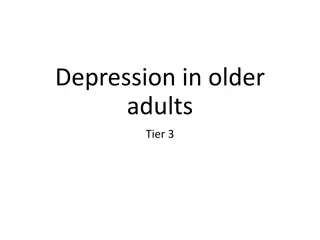Understanding Stress and Resilience in Older Adults
Explore the complex interplay between stress and resilience in older adults, examining models of physical and neurological resilience, recovery trajectories after hip fracture, and dynamic indicators of resilience. Considerations include psychosocial resilience factors like external support, social networks, and personal attributes. Insights are drawn from cognitive resilience odds, mortality among Holocaust survivors, and interventions promoting resilience in aging populations.
Download Presentation

Please find below an Image/Link to download the presentation.
The content on the website is provided AS IS for your information and personal use only. It may not be sold, licensed, or shared on other websites without obtaining consent from the author. Download presentation by click this link. If you encounter any issues during the download, it is possible that the publisher has removed the file from their server.
E N D
Presentation Transcript
Stress and Resilience in Older Adults Cathleen Col n-Emeric, MD, MHS
Will the Castle Fall? Strength of attack (magnitude of acute stressor) Prior exposure to low level stressors Quality of construction and maintenance over time (reserve) How quickly it can deploy defenses and repair damage (resilience)
Objectives Review how stress is conceptualized in models of resilience across disciplines Hormesis and Eustress vs Distress Considerations for stress in Resilience promoting interventions 3
Recovery Trajectories after Hip Fracture J Am Geriatr Soc. 2019 Dec;67(12):2519-2527 5
Physical Resilience Model drawn from Ecology J Am Geriatr Soc. 2019 Dec;67(12):2650-2657 6
Dynamic Indicators of Resilience (DIORs) 7 Exp Gerontol. 2021 Jul 1;149:111341.
Odds of Cognitive Resilience with Severe AD Pathology Aging Brain. 2023; 3: 100065. 9
Psychosocial Resilience External Support Social networks Environment Resources Chronic Stressors Poverty Discrimination War Low education Family dysfunction Larger Hole + Personal Attributes Secure early attachments Temperament Health Self-awareness Self-efficacy Humor, optimism Dialogues Clin Neurosci. 2003 Sep; 5(3): 273 280 10
12 J Am Geriatr Soc. 2023; 71(8): 2381-2392.
Pain Recovery after Knee Replacement Age, Cognition, Depression Low Resilience (5%) Depression Usual Recovery (59%) High Resilience (36%) 14
Worst Pain Recovery How is pain recovery different for people with low psychosocial resilience? How is pain recovery different for people with depression? 15
Hormesis What Doesnt Kill you Makes you Strong Examples in Health & Medicine Exercise Intermittent fasting/caloric restriction PTH analogues Skeletal loading Ischemic preconditioning Rapamycin? Eustress Distress Trends in Endocrinology & Metabolism 2019 30944-958DOI: (10.1016/j.tem.2019.08.007) 16
Hormesis is an Evolutionarily Conserved Process Calabrese, E.J., Mattson, M.P. npj Aging Mech Dis3, 13 (2017). 17
Implications for Resilience-Promoting Interventions Minimize Acute Stress Type/duration of anesthesia Vaccination Prevent co- stressors (e.g., delirium) Optimize Eustress Exercise Intermittent fasting Geroprotective agents? Ischemic preconditioning? Common mechanisms of hormesis? Minimize Chronic Distress SDOH Anti-amyloid therapy? Avoid obesity Social engagement 18























